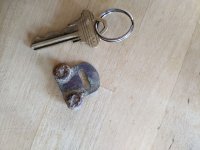Derk
Jr. Member
- Sep 30, 2018
- 43
- 43
- Primary Interest:
- All Treasure Hunting
I found this and several other, very small(pea sized or less) meteorite-like stones attached to my magnet while magnet fishing a bridge that I chose strictly because of its location being directly inline with the path of a rather large fireball that was recorded by a patrol car's dash cam a couple years ago. Could this be a possible surviving piece from that fall that land in the river? Below, I will post a link to that fireball video too.
Fireball Video:
Fireball Video:




